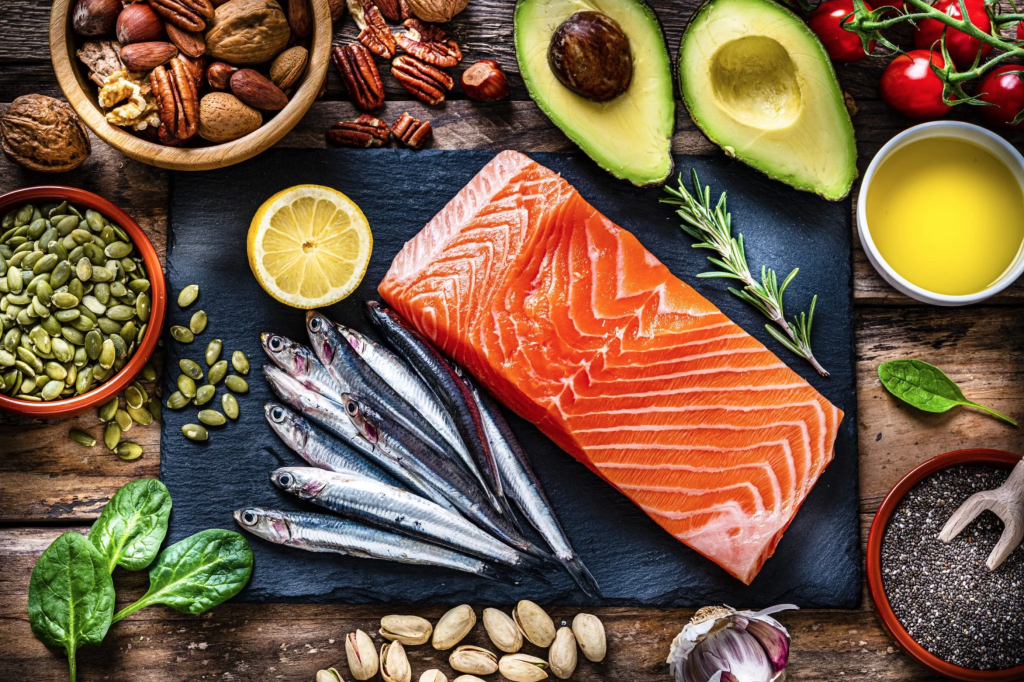Hello and welcome to the Stepwise Enhanced Blog Post Series. In this series we will explore a number of nutrition topics with the simple goal of providing you with more information. This series is meant to be an educational supplement to your current Enara program as we will dive deeper into topics than a traditional appointment window may allow. The fifth edition will dive into the world of fats and more specifically, omega-3’s and omega-6’s.
Saturated Fats vs Unsaturated Fats
In the world of dietary fats there are two distinctive types: saturated fats and unsaturated fats.
Saturated fats, for starters, are solid at room temperature. Most come from animal sources, like meat and dairy. Plant sources exist as well and include tropical oils such as palm, palm kernel, and coconut. They are called saturated fats because each carbon in the structure has a hydrogen attached, making it fully hydrogenated. They also have no double bonds in their structure, a key structural difference from unsaturated fat. The American Heart Association (AHA) recommends that no more than 6% of calories come from this type of fat (1), while the Dietary Guidelines for Americans recommend no more than 10% of calories (2) come from this fat. In the context of a 2,000 calorie diet that’s about 13-22 grams of saturated fat per day.
Here are examples of foods with saturated fat:
- Animal meat including beef, poultry, pork
- Certain plant oils such as palm kernel or coconut oil
- Dairy products including cheese, butter, and milk
- Processed meats including bologna, sausages, hot dogs, and bacon
- Pre-packaged snacks including crackers, chips, cookies, and pastries
Unsaturated fats, on the other hand, are liquid at room temperature and differ in chemical structure as they contain at least one double bond and fewer hydrogen atoms. This class can be further broken down into two categories, determined by the amount of double bonds in the structure. Monounsaturated fats have one double bond, while polyunsaturated fats have two double bonds. The AHA recommends that most of your daily fat intake should come from these unsaturated fats. (1) While the linear relationship between saturated fat intake and risk of heart disease is controversial, it is generally accepted that replacing saturated fat with unsaturated fat is health promoting. Unsaturated fats remain the healthiest type of fat out there. (2) Replacing saturated fats with anything, however, is not necessarily a slam dunk to be health promoting. For example, replacing them with refined carbohydrates has not been shown to be beneficial. (2)
1. Monounsaturated fats are found in high concentrations in:
- Olive, peanut, and canola oils
- Avocados
- Nuts such as almonds, hazelnuts, and pecans
- Seeds such as pumpkin and sesame seeds
2. Polyunsaturated fats are found in high concentrations in
- Sunflower, corn, soybean, and flaxseed oils
- Walnuts, Flax seeds
- Fish
- Canola oil (though higher in monounsaturated fat, it’s also a good source of polyunsaturated fat)
In this post we will dive deeper into the polyunsaturated fats, also known as PUFAs.
Polyunsaturated Fats (PUFAs)
Let’s delve a bit deeper into Polyunsaturated Fats (PUFA) as these are where the essential fatty acids, omega-3 and omega-6, are housed. Circling back to a concept in the protein post, essential here means the body is reliant on outside sources for them. The body cannot make them. Let’s discuss both omega-3 and omega-6.
Omega-3
For Omega-3’s there are three types which are the most important for humans: alpha-linolenic acid (ALA), eicosapentaenoic acid (EPA), and docosahexaenoic acid (DHA). ALA is the most common. It’s found in plant foods and is a precursor to EPA or DHA. The conversion process, however, is pretty inefficient. This is an important piece of information because ALA is mostly found in plant foods and EPA and DHA are mostly found in fish. Before we get into more detail about where these fatty acids come from, let’s go over the benefits of them.
The list of benefits for including omega-3 fatty acids in your diet is a lengthy one. They can reduce your risk of cardiovascular disease and/or reduce your risk of death if you have cardiovascular disease. They exert positive effects on the arteries, keeping them smooth and helping to keep plaque from forming. Furthermore, they reduce the risk of blood clots and help to dampen inflammation in the body. (3) DHA has a key function in skin integrity, eye functionality, as well as brain function. EPA plays roles in a number of physiological functions. It also helps to reduce inflammation. (4)
Sounds great right? But how much should you get and from where? The best source is fatty fish and the American Heart Association recommends at least 2 servings each week for those without heart disease. Cold water varieties of fish, including anchovies, mackerel, tuna, salmon, sardines, and herring contain good amounts of the essential fatty acid. (3) Fish is the best source but if it is not an option several plants contain ALA. Milled flaxseeds, flaxseed oil, chia seeds, walnuts, soy foods and canola oil are good sources. (3) Daily recommendations for omega-3 intake are 1.6g per day for men and 1.1g per day for women. (5) For EPA and DHA, 500mg per day is recommended.
| ALA (g per serving) | DHA (g per serving) | EPA (g per serving) | |
| Flaxseed oil (1 tbsp) | 7.26 | ||
| Chia Seeds (1oz) | 5.06 | ||
| Walnuts (1oz) | 2.57 | ||
| Flaxseed (1 tbsp) | 2.35 | ||
| Canola Oil (1 tbsp) | 1.28 | ||
| Salmon (3oz) | 1.22-1.24 | 0.35-0.59 | |
| Herring (3oz) | 0.94 | 0.77 | |
| Sardines (3oz) | 0.74 | 0.45 | |
| Mackerel (3oz) | 0.59 | 0.43 | |
| Tuna in Water (3oz) | 0.17 | 0.02 |
ALA is more easily accessible than its counterparts. Does it impart the same benefits to the body as EPA and DHA? Unfortunately, the answer is not clear. Per the National Institute of Health, most of the scientific research out there focuses on the benefits of EPA and DHA from fish consumption or supplement intake, not on ALA intake from plants. As a glimmer of hope, the agency does report that many observational studies link intake with improved outcomes, though more research on the topic is still needed. (5)
Omega-6
Omega-6’s don’t get the same shine as omega-3’s. While this may be warranted, omega-6’s certainly have their positive points as well. They are found in vegetable oils, nuts, and seeds. According to the Food and Nutrition Board of the U.S. Institute of Medicine, the adequate level of intake for men is 17g/d and 12g/d for women, aged 19-50.
Here are the amounts of omega-6’s in 100 grams (3.5 ounces) of the following foods:
- Soybean oil: 50 grams
- Corn oil: 49 grams
- Mayonnaise: 39 grams
- Walnuts: 37 grams
- Sunflower seeds: 34 grams
- Almonds: 12 grams
- Cashew nuts: 8 grams
A very key consideration with these two essential fatty acids is the ratio in which they are consumed in relation to each other. Studies suggest that typical Western Diets have a ratio of 15:1 omega-6 to omega-3. An ideal ratio is no greater than 4:1 omega-6 to omega-3. Since these PUFAs are more healthful than their saturated counterparts, it is not recommended to necessarily decrease intake of 6 but to increase the consumption of omega-3. (6)
The most common omega-6 is linoleic acid which the body can convert to arachidonic acid, which is pro-inflammatory. This acid does have a key role in the immune system however too much can increase the risk of inflammation. This is part of the reason why the ratio is key. Omega-6’s also positively impact cholesterol and sensitivity to insulin. (7)
In conclusion, it is a health promoting practice to replace saturated fat with unsaturated fat. Omega-3’s and omega-6’s are essential fatty acids under the umbrella of unsaturated fat, the most healthful type of fat. They have many benefits to the human body and an ideal intake ratio is no greater than 4:1 (omega-6:omega-3). I hope this post was helpful in providing a better understanding of fats.
References
- Moll, J; The Difference Between Saturated Fats and Unsaturated Fats; Verwellhealth; https://www.verywellhealth.com/difference-between-saturated-fats-and-unsaturated-fats-697517; Updated October 5, 2021; Accessed December 2, 2021.
- Types of Fat; Harvard T.H. Chan School of Public Health; https://www.hsph.harvard.edu/nutritionsource/what-should-you-eat/fats-and-cholesterol/types-of-fat; Accessed December 2, 2021.
- Omega-3 Fatty Acids; Cleveland Clinic; https://my.clevelandclinic.org/health/articles/17290-omega-3-fatty-acids; Accessed December 2, 2021.
- Hjalmarsdottir F; The 3 Most Important Types of Omega-3 Fatty Acids; https://www.healthline.com/nutrition/3-types-of-omega-3#_noHeaderPrefixedContent; Updated May 27, 2019; Accessed December 1, 2021.
- Omega-3 Fatty Acids; National Institute of Health; https://ods.od.nih.gov/factsheets/Omega3FattyAcids-HealthProfessional/; Updated August 4, 2021; Accessed December 1, 2021.
- Robertson, R; Omega-3-6-9 Fatty Acids: A Complete Overview; https://www.healthline.com/nutrition/omega-3-6-9-overview#omega-6; Updated October 22, 2020; Accessed December 1, 2021.
- No Need to Avoid Healthy Omega-6 Fats; Harvard Health Publishing; https://www.health.harvard.edu/newsletter_article/no-need-to-avoid-healthy-omega-6-fats; Published: August 20, 2019; Accessed December 1, 2021.



